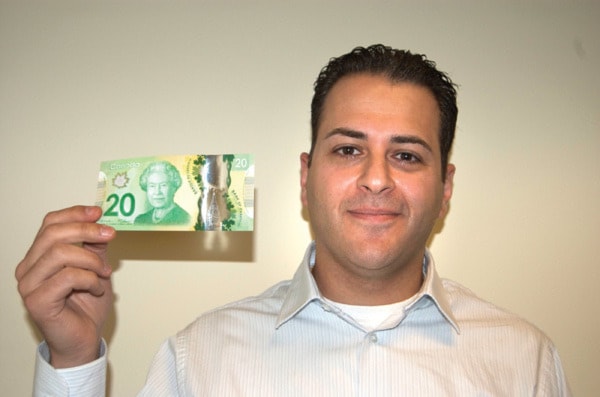After a recent rise in counterfeit bills in the area, Bank of Canada representatives have been making their way around the region educating the RCMP, store owners and employees about how to detect fakes.
Farid Salji, analyst and member of the Bank of Canada’s currency awareness and education team has a goal of decreasing the amount of fraud that occurs in the Interior.
He has been teaching merchants and police how to identify fake Canadian notes, as well as how to prevent debt card, cheque, money order and currency fraud, through the use of a number of advanced and easy-to-use kits.
The new series of polymer bills, including the new $20-bill which will be released in November of this year, has three simple and quick ways of testing for authenticity.
No more holding the bill up to the light, squinting your eyes and tilting your head.
Salji says the new bills, “are way more durable, they are environmentally friendly, and they are state of the art when it comes to security. Whenever we design a new series, we pride ourselves on security being our top priority, and these are the best notes in the world when it comes to security.”
Rumors that the polymer bills have melted from the summer heat in the Okanagan area are, from what Salji believes, just rumors.
He explains, “these bills have been durability tested for extreme cold and extreme heat. So as long as they are being used the way money is supposed to they would be fine.” He continues to explain that the new bills are 100 per cent waterproof, so they can go through complete laundry cycle and come out without a problem.
A number of security features have gone into the new notes.
“It is a combination of complex holography and transparency,” says Salji.
These are state-of-the-art bills, explains Salji, so a counterfeiter cannot actually replicate them, they can only mimic certain features.
Criminals usually try to chat while handing over the fake money in an attempt at distraction, he says. He explains that those trying to pass counterfeit cash will most likely come by at busy times, which is why merchants always have to be aware of the cash they are being given.
Salji says that store employees can now check for counterfeits more quickly than ever.
The $20s, $50s and $100s have all the same security features but have a different person and different building.
Each bill should have the same portrait in the centre of the bill in the foil to the right.
When tilted, the foil goes through a subtle colour change. The bottom image should be completely different than the top. The image should be very sharp in colour and detail. The building’s doors, walls, and windows, should also all have a colour shift when tilted and the denominations should change colour.
The $20 also has a Canadian flag on the building that has the maple leaf on it when tilted.
When the bill is flipped around everything on the back is exactly the same as on the front. The clarity, quality, and sharpness is all there, only the image is reverse.
There is also a maple leaf located to the left of the bill which should be completely transparent.
“While it takes a while to explain what to look for,” says Salji, “it takes you a second to check for the three details. Just take a quick glance at the bill and look for the portrait, the foil and the transparency, if all three are there, it is almost certainly not a fake.”
